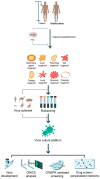Modeling Host-Virus Interactions in Viral Infectious Diseases Using Stem-Cell-Derived Systems and CRISPR/Cas9 Technology
- PMID: 30704043
- PMCID: PMC6409779
- DOI: 10.3390/v11020124
Modeling Host-Virus Interactions in Viral Infectious Diseases Using Stem-Cell-Derived Systems and CRISPR/Cas9 Technology
Abstract
Pathologies induced by viral infections have undergone extensive study, with traditional model systems such as two-dimensional (2D) cell cultures and in vivo mouse models contributing greatly to our understanding of host-virus interactions. However, the technical limitations inherent in these systems have constrained efforts to more fully understand such interactions, leading to a search for alternative in vitro systems that accurately recreate in vivo physiology in order to advance the study of viral pathogenesis. Over the last decade, there have been significant technological advances that have allowed researchers to more accurately model the host environment when modeling viral pathogenesis in vitro, including induced pluripotent stem cells (iPSCs), adult stem-cell-derived organoid culture systems and CRISPR/Cas9-mediated genome editing. Such technological breakthroughs have ushered in a new era in the field of viral pathogenesis, where previously challenging questions have begun to be tackled. These include genome-wide analysis of host-virus crosstalk, identification of host factors critical for viral pathogenesis, and the study of viral pathogens that previously lacked a suitable platform, e.g., noroviruses, rotaviruses, enteroviruses, adenoviruses, and Zika virus. In this review, we will discuss recent advances in the study of viral pathogenesis and host-virus crosstalk arising from the use of iPSC, organoid, and CRISPR/Cas9 technologies.
Keywords: CRISPR/Cas9 genome editing; adult stem cell; host-virus interactions; induced pluripotent stem cell; modeling of viral pathogenesis; organoid.
Conflict of interest statement
The authors declare no conflict of interest.
Figures

Similar articles
-
Modeling Viral Infectious Diseases and Development of Antiviral Therapies Using Human Induced Pluripotent Stem Cell-Derived Systems.Viruses. 2015 Jul 13;7(7):3835-56. doi: 10.3390/v7072800. Viruses. 2015. PMID: 26184286 Free PMC article. Review.
-
CRISPR-Cas based targeting of host and viral genes as an antiviral strategy.Semin Cell Dev Biol. 2019 Dec;96:53-64. doi: 10.1016/j.semcdb.2019.04.004. Epub 2019 Apr 8. Semin Cell Dev Biol. 2019. PMID: 30953741 Free PMC article. Review.
-
Modeling of Autism Using Organoid Technology.Mol Neurobiol. 2017 Dec;54(10):7789-7795. doi: 10.1007/s12035-016-0274-8. Epub 2016 Nov 14. Mol Neurobiol. 2017. PMID: 27844287 Review.
-
CRISPR/Cas9-Based Antiviral Strategy: Current Status and the Potential Challenge.Molecules. 2019 Apr 5;24(7):1349. doi: 10.3390/molecules24071349. Molecules. 2019. PMID: 30959782 Free PMC article. Review.
-
iPSC-derived three-dimensional brain organoid models and neurotropic viral infections.J Neurovirol. 2023 Apr;29(2):121-134. doi: 10.1007/s13365-023-01133-3. Epub 2023 Apr 25. J Neurovirol. 2023. PMID: 37097597 Free PMC article. Review.
Cited by
-
Does the Global Outbreak of COVID-19 or Other Viral Diseases Threaten the Stem Cell Reservoir Inside the Body?Stem Cell Rev Rep. 2021 Feb;17(1):214-230. doi: 10.1007/s12015-020-10108-4. Epub 2021 Jan 5. Stem Cell Rev Rep. 2021. PMID: 33403490 Free PMC article. Review.
-
Special Issue: Applications of CRISPR Technology in Virology 2018.Viruses. 2019 Sep 10;11(9):839. doi: 10.3390/v11090839. Viruses. 2019. PMID: 31509984 Free PMC article.
-
Applications of Brain Organoids for Infectious Diseases.J Mol Biol. 2022 Feb 15;434(3):167243. doi: 10.1016/j.jmb.2021.167243. Epub 2021 Sep 15. J Mol Biol. 2022. PMID: 34536442 Free PMC article. Review.
-
Organ-on-a-chip technology: a novel approach to investigate cardiovascular diseases.Cardiovasc Res. 2021 Dec 17;117(14):2742-2754. doi: 10.1093/cvr/cvab088. Cardiovasc Res. 2021. PMID: 33729461 Free PMC article. Review.
-
Orchestration of antiviral responses within the infected central nervous system.Cell Mol Immunol. 2024 Sep;21(9):943-958. doi: 10.1038/s41423-024-01181-7. Epub 2024 Jul 12. Cell Mol Immunol. 2024. PMID: 38997413 Free PMC article. Review.
References
-
- Sarrazin C., Kieffer T.L., Bartels D., Hanzelka B., Muh U., Welker M., Wincheringer D., Zhou Y., Chu H.M., Lin C., et al. Dynamic hepatitis c virus genotypic and phenotypic changes in patients treated with the protease inhibitor telaprevir. Gastroenterology. 2007;132:1767–1777. doi: 10.1053/j.gastro.2007.02.037. - DOI - PubMed
Publication types
MeSH terms
LinkOut - more resources
Full Text Sources
Medical

